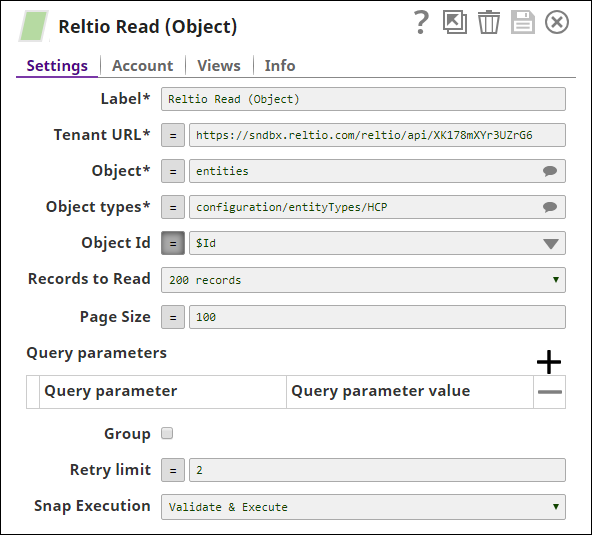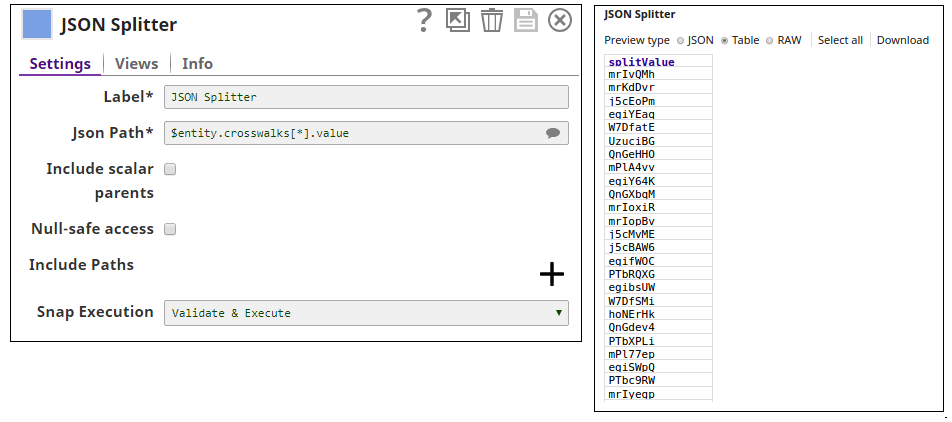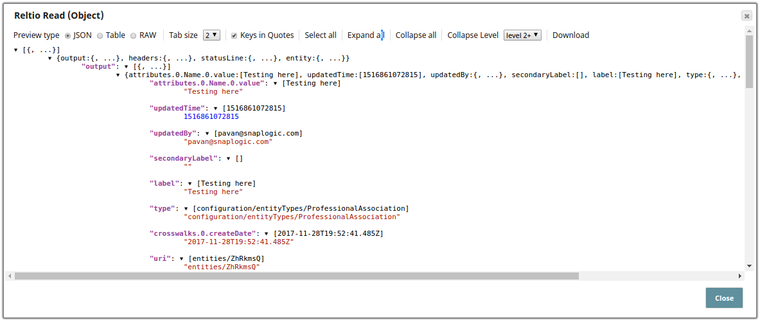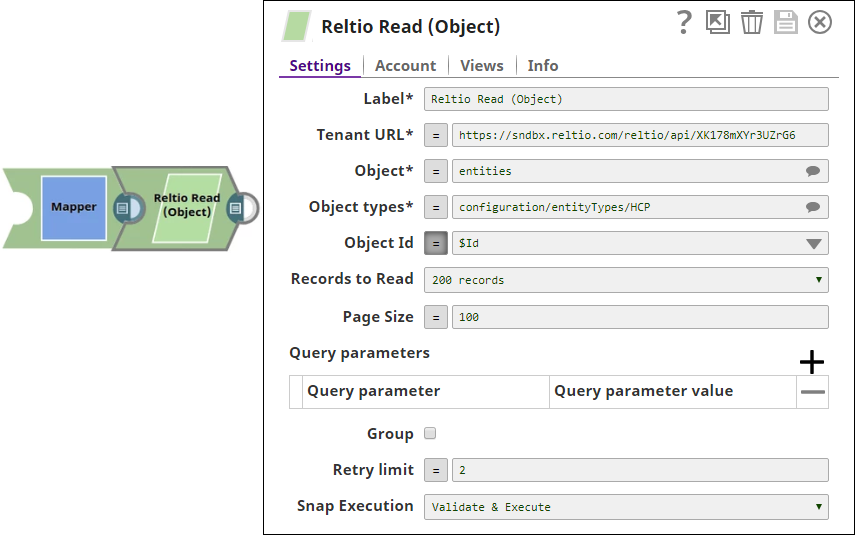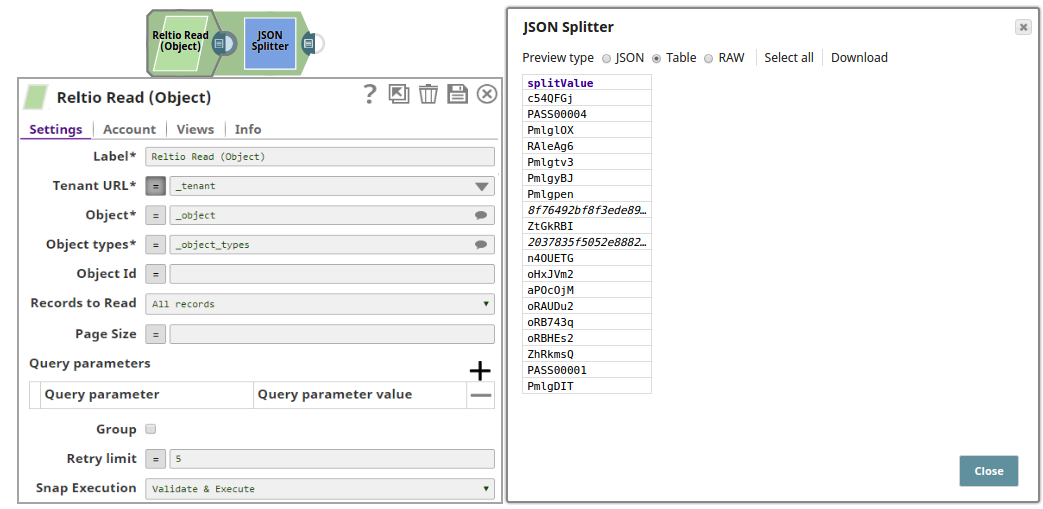This Snap reads the Reltio Objects (Entities only) from a specified Tenant.
ETL Transformations & Data Flow
This Snap reads the data from the Reltio from the provided Object and Object Type.
Input & Output
- Input:
There should be one input view where we need to provide the type or the value which is also suggested in Input Schema. Only the fields marked in * are the required inputs. Others are mandatory. - Output:
The response contains the attributes value for each entity object (separate record for each input entity) provided.
Modes
- Ultra pipelines: May work in Ultra Pipelines.
- Spark (Deprecated) mode: Not supported in Spark mode.
A valid Reltio account with the tenant ID for the Tenant URL, or an API key for the Account Settings to be generated.
An access from Reltio to merge the objects or entities from the Tenant.
None at this time.
Account & Access
This Snap uses account references created on the Accounts page of SnapLogic Manager to handle access to this endpoint. See Reltio Account for information on setting up this type of account.of account.
Views
| Input | This Snap has exactly one document input view. |
|---|---|
| Output | This Snap has exactly one document output view. |
| Error | This Snap has at most one document error view and produces zero or more documents in the view. |
Settings
Label
Required. The name for the Snap. You can modify this to be more specific, especially if you have more than one of the same Snap in your pipeline.
Required. Specifies the Reltio host with Tenant ID. Use the format, https://<reltio_host>/reltio/api/<tenant_id>.
| Note |
|---|
The values can be passed directly or using the pipeline parameters but not through the upstream. |
Example: https://sndbx.reltio.com/reltio/api/XK178mXYr3UZrG6/
Detault value: [None]
Required. The Reltio Object to be created. This is a suggestible field. Reltio typically has four objects:
entities: Entities are objects for the representation such as People,Company and Locations.
categories: Entities are structured under the Categories. An entity can belong to multiple categories.
interactions: Interactions are the actions between two or more entities that have an impact on one another. For example: email is an interaction that sends emails to one one or several entities. One can also define different types of interactions in their instance depending on the business model.
relations: Define the links between entities.
The suggestion works only when the valid account or the tenant URL is provided.
On this Page
| Table of Contents | ||||
|---|---|---|---|---|
|
| Snap type: | Read | ||||||
|---|---|---|---|---|---|---|---|
| Description: | This Snap reads the Reltio objects from a specified Tenant. ETL Transformations & Data FlowThis Snap reads the Reltio data from the provided Object and Object Type. Input & Output
| ||||||
| Prerequisites: | A valid Reltio account with the tenant ID for the Tenant URL, or an API key for the Account Settings to be generated. The Reltio account must have sufficient access to read the objects from the Tenant. | ||||||
| Limitations and Known Issues: |
| ||||||
| Configurations: | Account & AccessThis Snap uses account references created on the Accounts page of SnapLogic Manager to handle access to this endpoint. See Reltio Account for information on setting up this type of account.of account. Views
| ||||||
| Troubleshooting: | |||||||
Settings | |||||||
Label | Required. The name for the Snap. You can modify this to be more specific, especially if you have more than one of the same Snap in your pipeline. | ||||||
| Tenant URL | Required. Specifies the Reltio host with Tenant ID. Use this format:
Example: https://test.reltio.com/reltiotest/api/XKiqdracb178fmuXYr3U7ZrG6/ Default value: [None] | ||||||
| Object | Required. The Reltio object to be read. This is a suggestible field. Reltio typically has four objects:
The suggestion works only when the valid account or the tenant URL is provided.
Default value: [None] | ||||||
| Object Types | Required. The suggestible field provides options to choose an object type for a particular Object. The suggestion works only when a valid Account, Tenant URL and Object are provided. This value can be provided dynamically as a pipeline parameter or directly in the Snap but not as an upstream parameter. Default value: [None] | ||||||
| Object Id | The object ID describes the part of 'uri' of the Reltio API response. For example: “uri”: “entities/abcd1234” is a part of Reltio Object (Entity here) so abcd1234 is the Object Id (Entity Id here). In Reltio UI, it says like “Entity ID” in profile of each Entity Object. This is either being taken from upstream or pipeline parameters. Default value: [None] | ||||||
| Records to Read | Specifies the number of records to read from an object. The available options are: Up to 200 records: The Snap retrieves records up to 200 from the specified Reltio object/ object type. All records: The Snap retrieves all the records from the specified object/object type (except "interactions" object). Default value: Up to 200 records | ||||||
| Page Size | Conditional. Specifies the page size to be set for the Reltio read functionality. This property is applicable only when the option, All records is selected on Records to Read property for Relations object. The Snap sets the pagination for the records in the Relations object. The values can be passed using the pipeline parameters or via the upstream Snaps. The minimum value may be 1 and there is no upper bound for this property. Minimum value: 1 Maximum value: None Default value: 100 | ||||||
| Query parameters | Defines the query parameters and their values. The query parameters are attached to the URL using the http query parameter syntax, separated by '&' and are added as 'key=value' pairs. For example, when Expression is disabled, the Query Parameter 'max' with the key Value '5' displays the five records of the Object on the output preview. | ||||||
| Query parameter | Specifies the key used in the HTTP request for Reltio. Default value: [None] | ||||||
| Query parameter value | Specifies the key value for the particular Query parameter used. Default value: [None] | ||||||
| Batch size | Specifies the number of records to be processed in a single API call.
Default value: 50 | ||||||
| Thread limit | Required. Specifies the maximum number of threads for the Snap to create Reltio Objects.
Default value: 20 | ||||||
| Query parameters | Defines the query parameters and their values. The query parameters are attached to the URL using the http query parameter syntax, separated by '&' and are added as 'key=value' pairs. For example, when expression disabled, the Query Parameter 'max' with the key Value '5' displays the five records of the Object on the output preview. | ||||||
| Query parameter | Specifies the key used in the HTTP request for Reltio. Default value: [None] | ||||||
| Query parameter value | Specifies the key value for the particular Query parameter used. Default value: [None] | ||||||
| Group | This value indicates whether or not to nest the values of the same attributes. If not selected, then an attribute having multiple values is displayed in two different tags else it will be grouped in a single tag. Default value: Not selected | ||||||
| Retry limit | Determines the maximum number of attempts to retrieve the response. Since Reltio uses the exponential backoff, the retry mechanism applies for HTTP Status Codes 502, 503 and 504 only and does not apply for the HTTP Status Codes 401, 403, 404, 500.
Default value: 5 Maximum value: 10 | ||||||
| Group | Nests multiple values of the same attribute by grouping them into a single tag. If not selected, then an attribute with multiple values is displayed in two separate tags. Default value: Not selected | ||||||||
|---|---|---|---|---|---|---|---|---|---|
| Retry limit |
| ||||||||
Snap Execution | Select one of the following three modes in which the Snap executes:
Default Value: Execute only |
Basic Use Cases
1. The Reltio Read (Object) Snap with Pagination Settings
In this pipeline, the Reltio Read (Object) reads the objects from Relations, with a page size of 100, and of records Up to 200. Additionally, the JSON Splitter Snap splits the records based on the specified split value.
2. The Reltio Read (Object) Snap Functioning as a Standalone Snap in a Pipeline
The following pipeline describes how the Snap functions as a standalone Snap in a pipeline:
Typical Snap Configurations
The key Snap Configurations are:configurations are:
Without Expressions
The values are directly passed into the Snap:
With Expressions
Query- Query from Upstream
In the
- Snap settings shown below, the
- ID value is passed using an upstream Snap:
Pipeline Parameter
In the configuration shown below configuration, the values (Tenant URL, Object and Object types) are passed using the pipeline parameters:
The values as set in the Pipeline parameters:
Downloads
| Multiexcerpt include macro | ||||
|---|---|---|---|---|
|
| Attachments | ||
|---|---|---|
|
| Insert excerpt | ||||||
|---|---|---|---|---|---|---|
|

